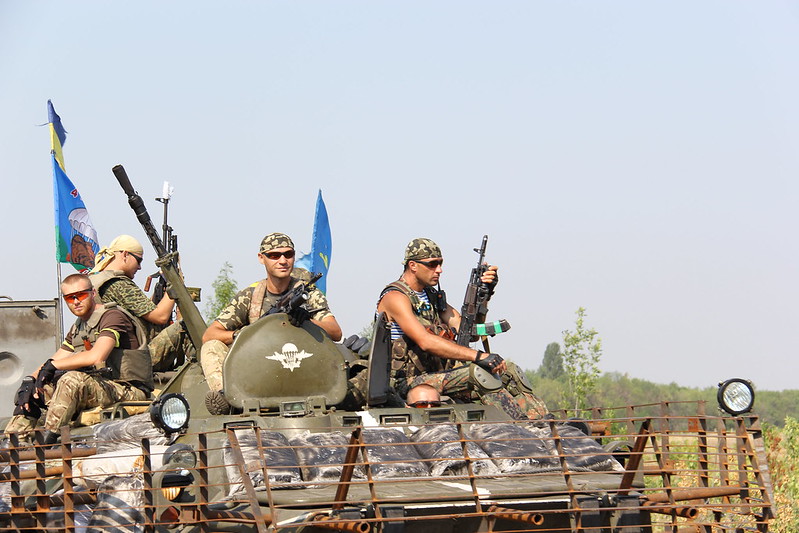
There are two potential nuclear dimensions to a war in Ukraine, which could create a massive humanitarian disaster and have profound global implications.
In the first week of February, US officials estimated that if war using conventional weapons broke out, 25,000 to 50,000 civilians could die in Ukraine, along with 5,000 to 25,000 Ukrainian and 3,000 to 10,000 Russian soldiers, and that between 1 and 5 million people would flee their homes and become refugees.
The toll could be much greater, especially if the conflict spread to neighbouring countries and NATO forces became embroiled. As Max Fisher wrote in the New York Times on 15 Feb: “threats and bluffs work best when they are backed up by action, increasing the risk of a war that neither side may truly want”, and “the more both sides try to make their threats credible, for example by relocating troops, the more they heighten the risk of a miscalculation that could careen out of control. He quotes Columbia University international relations scholar Dr. Keren Yarhi-Milo: “Every day that we’re not resolving it, we are increasing the percentage chance that something will go wrong”.
Conventional wars can be horrific enough. There must scarcely be a family in Russia or Ukraine without a relative among the close to 14 million Russians or 7 million Ukrainians who died during World War II, and Ukraine has been scarred by repeated invasions from both east and west. Modern weapons have greater destructiveness, range, accuracy while military spending has continued to increase to record levels even through the COVID-19 pandemic, to a staggering USD1981 billion in 2020. NATO members account for 56%, the US alone for 39%, and Russia for 3.1% of the global total.
Eruption of armed conflict in Ukraine risks involving not only Ukraine and Russia (and Crimea and parts of eastern Ukraine it has occupied), but neighbouring countries where Russian forces are stationed – Belarus and Modova, and many of NATO’s 30 members in Europe and across the Atlantic, notably the US, with forces stationed in many other NATO countries.
However a war in Ukraine could have two potentially devastating nuclear dimensions.
Nuclear power plants as potential ‘dirty’ bombs
Nuclear power plants are huge potential pre-positioned radiological weapons.
Ukraine, site of the world’s worst ever civilian nuclear disaster in Chernobyl, has 15 operating nuclear power reactors, in 4 nuclear plants in different parts of the country. The largest is Zaporozhye, in Enerhodar in the southeast of the country. It lies on the east (towards Russia) side of the Dniepr River, 330km west of the city of Donetsk and 200 km from the border of the Donetsk region, part of which has been taken over by Russian/Russian-backed forces. The site has 6 nuclear reactors of 950 Mw each, producing about a quarter of Ukraine’s electricity. It is the second largest nuclear power plant in Europe and one of the 10 largest in the world.
Like most nuclear power plants, highly radioactive and hot used reactor fuel is onsite in cooling ponds, as the fuel needs to be actively cooled for several years, before being put in dry assemblies, which are also on site. As reactor fuel becomes more radioactive the longer it is inside a reactor, cooling ponds often contain more radioactivity in the spent fuel than the reactors themselves do, but are housed in simple buildings without the multiple engineered layers of containment reactors typically have. As we saw in the Fukushima nuclear disaster, reactor meltdowns and explosions releasing vast amounts of radioactivity do not require a high level military assault breaching reactor cores. They can happen simply from disruption to the constant power and circulating water system required to keep reactors and spent fuels pools cool. At the Fukushima Daiichi site at the time of the disaster, 70% of all the radioactivity on site was in the spent fuel pools.
Nobel laureate physicist Prof Joseph Rotblat described in his landmark 1981 study “Nuclear radiation in warfare” that precision-guided bombardment or a commando raid with conventional weapons could rupture a reactor’s containment and pressure vessel, but that very serious radiological consequences could ensue even without rupture of the pressure vessel if the reactor cooling system were put out of action. He stated that: “In a pressurized water reactor [all Ukraine’s operating power reactors are of this type] the melt-down of the core could occur within less than one minute after the loss of coolant”.
War in Ukraine could turn nuclear if any of its nuclear power reactors and/or spent reactor fuel cooling ponds were damaged sufficiently to cause loss of coolant meltdown and/or explosion. The Russian-made Buk missile which brought down Malaysian Airlines flight MH17 in eastern Ukraine in 2014, killing all 298 people on board, appears to have been launched by Russian-backed separatists. A nuclear power plant may be an attractive high-impact target, including for proxy groups who may not be under direct military control but have access to high level weaponry.
Russia is one of the growing number of states actively engaged in cyberwarfare. Nuclear power plants and other nuclear facilities have repeatedly been targets of cyberattack, including infamously the Stuxnet computer virus targetted by Israel and the US to disrupt Iran’s uranium enrichment centrifuges in 2009.
Rotblat also described how the radioactive fallout from a damaged reactor, and even more so from an explosion in a spent fuel pool, could release more and longer-lived radioactivity than detonation of a nuclear bomb.
Thus nuclear power plants are effectively huge pre-positioned potential radiological weapons.
War turning nuclear
If fighting erupted in Ukraine, it would almost certainly begin with conventional weapons. Many of these have sufficient accuracy, range and destructiveness to put targets that are of high military value to Ukraine, Russia and NATO members at risk, even far from any frontline – like military and air bases; intelligence, command and logistical centres. Both Russian and NATO/US military doctrines allow first use of nuclear weapons in situations where the prospect of military defeat looms.
Russia has 1600 deployed strategic nuclear weapons, and 1912 tactical nuclear weapons. Most of the delivery systems for the latter can carry either conventional or nuclear warheads, increasing the risk of worst-case thinking and precipitous and over reaction on the other side, and the danger of the threshold to nuclear escalation being crossed.
The US has 1650 deployed strategic nuclear weapons, and 100 B-61 nuclear bombs deployed to bases in Belgium, Germany, Italy, Netherlands and Turkey for delivery by aircraft of those nations.
in addition, France has 280 deployed nuclear weapons, and the UK 120 deployed nuclear weapons.
If the threshold of use of nuclear weapons is crossed, those who have managed nuclear weapons and nuclear war plans tell us the risks or rapid and large-scale escalation are very high. The current Ukraine crisis involves not only complicated history, politics and personalities, but hundreds of senior officials; many thousands of civilian and military officials and advisors; multiple enormous complex and dispersed command, control and communications systems; a web of often unconnected communications across many time zones and languages; and through Russia and NATO involves the 4 nations that possess all the world’s 3750 currently deployed nuclear weapons, including all the 2000 nuclear weapons on high alert, ready to be launched on short notice (counted in minutes).
There is a lot that can go wrong.
Diplomacy to remove the danger of nuclear escalation is desperately urgent and needs to progress to negotiations among all nuclear armed states to eliminate their nuclear arsenals under strict verification and timelines. Otherwise it will be a matter of time before our luck finally runs out.




